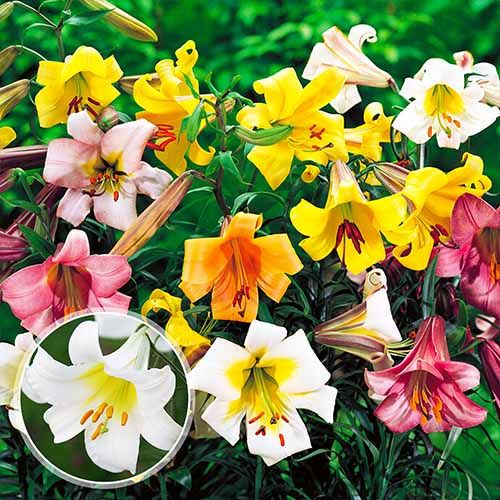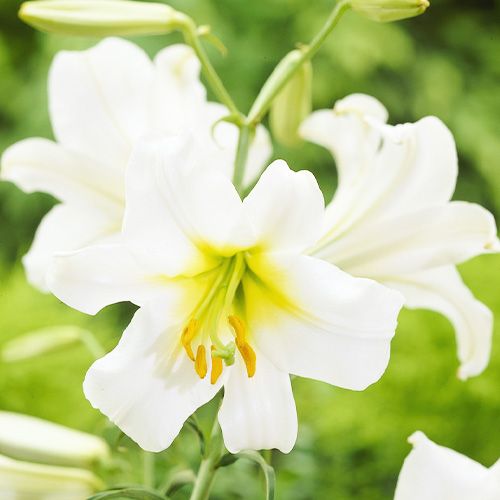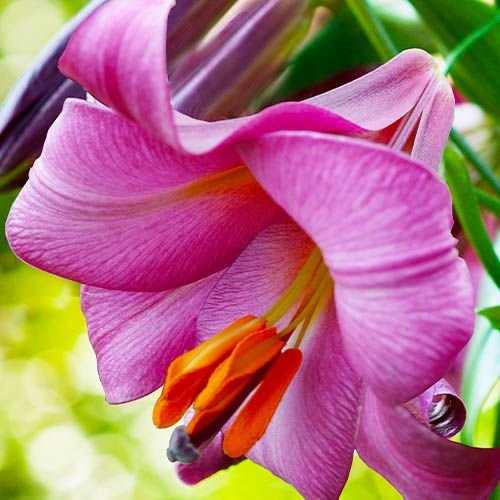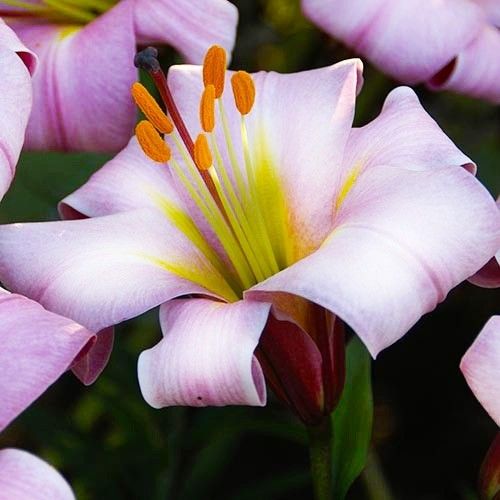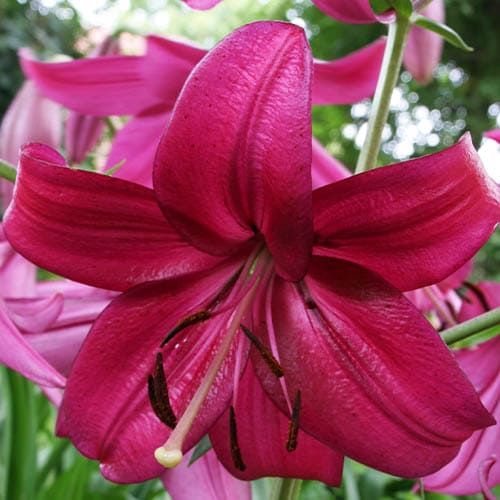
Trumpet Lilies
Trumpet Lilies
Last Reviews
All About Trumpet Lilies: Types, Meaning, and Care Tips
Trumpet lilies, also known as Aurelian lilies, are tall, elegant, and fragrant flowers that are popular in gardens and floral arrangements. Heres everything you need to know about trumpet lilies, including their types, meanings, and care tips:
Types of Trumpet Lilies:
There are many different types of trumpet lilies, with a wide range of colors and patterns. Some popular varieties include:
- Regale - A classic white trumpet lily with a yellow throat and a sweet fragrance.
- Golden Splendour - A tall, yellow trumpet lily with a dark center.
- African Queen - A deep orange-red trumpet lily with a light fragrance.
- Pink Perfection - A pink trumpet lily with a yellow center and a strong fragrance.
- Black Beauty - A dark purple trumpet lily with a yellow center and a light fragrance.
Meaning of Trumpet Lilies:
Trumpet lilies are associated with purity, renewal, and fertility, making them popular choices for wedding bouquets and other romantic occasions. They are also said to symbolize ambition and success, making them a great gift for someone starting a new business or embarking on a new chapter in their life.
Care Tips for Trumpet Lilies:
Trumpet lilies are relatively easy to care for, but they do require some specific conditions to thrive. Here are some tips for caring for trumpet lilies:

- Planting: Trumpet lilies should be planted in well-draining soil with plenty of organic matter. They prefer full sun or partial shade.
- Watering: Trumpet lilies need regular watering, especially during hot, dry weather. Be sure to water deeply to encourage deep root growth.
- Fertilizing: Trumpet lilies should be fertilized in the spring with a slow-release fertilizer designed for bulbs.
- Pruning: After the flowers have faded, cut the stem back to the base of the plant. Leave the foliage in place until it dies back naturally, as this will help to feed the bulb.
- Mulching: Mulch around the base of the plant with a layer of organic matter to help retain moisture and suppress weeds.
- Winter care: In colder climates, trumpet lilies may need to be lifted and stored indoors over the winter to protect them from freezing temperatures.
With proper care, trumpet lilies can provide years of beauty and fragrance in your garden or home.
The Meaning and Symbolism Behind Trumpet Lilies: What Do They Represent?
Since ancient times, lilies have been one of the most revered and enduring flowers in human history. They have different meanings depending on their color, shape, and origin and have been connected to numerous cultures, religions, and myths.
Trumpet lilies, as a type of lily, share some of the general meanings of the flower, such as purity, innocence, beauty, grace, and fertility. However, they also have some specific meanings that reflect their unique appearance and characteristics.
Some of the meanings and symbolism behind trumpet lilies are:
- Royalty and majesty: Trumpet lilies have a regal look and a commanding presence. They are often used to adorn palaces, churches, and ceremonial events. They symbolize dignity, elegance, nobility, and power.
- Divinity and spirituality: Trumpet lilies have a heavenly scent and a radiant color. They are often associated with angels, saints, and deities. They symbolize faith, devotion, holiness, and transcendence.
- Joy and celebration: Trumpet lilies have a cheerful and festive look. They are often used to celebrate weddings, birthdays, anniversaries, and other special occasions. They symbolize happiness, gratitude, love, and optimism.
- Respect and admiration: Trumpet lilies have a graceful and impressive look. They are often used to honor someones achievements, accomplishments, or qualities. They symbolize respect, admiration, appreciation, and recognition.
Types of Trumpet Lilies: A Guide to Popular Varieties and Their Characteristics
Todays market is filled with different varieties of trumpet lilies. Color, size, shape, fragrance, length of blooming, hardiness, and other characteristics are unique to each variety. Here are some of the most well-known trumpet lily varieties and what makes them special:
- African Queen: The flowers of this variety are a vibrant apricot-orange color with burgundy markings on the outside. It blooms in the middle to end of the summer and has a potent scent. It is hardy in zones 4 to 8 and can reach heights of up to 6 feet.
- Golden Splendor: The flowers of this variety are a vivid golden yellow with burgundy markings. It blooms in the middle to end of the summer and has a potent scent. It can reach a height of 4 feet and is hardy in zones 4 to 8.
- Pink Perfection: The flowers of this variety are purplish-pink with deep carmine markings. It blooms in the middle to end of the summer and has a potent scent. It can reach a height of six feet and is hardy in zones 4 to nine.
- Regale: The flowers of this variety are all-white, with golden throats and pinkish-purple striations around the periphery. It blooms in midsummer and has a potent scent. It is hardy in zones 3 to 9 and can grow up to 5 feet tall.
- White Henryi: The flowers of this variety are creamy white with yellow throats and brown spots inside. It blooms in the middle of summer and has a light scent. It is hardy in zones 3 to 9 and can grow up to 5 feet tall.
Giant Trumpet Lilies Bouquets: Ideas and Inspiration for Stunning Flower Arrangements
For stunning flower arrangements that will dazzle everyone who sees them, giant trumpet lilies are ideal. They are perfect for any occasion due to their size, bold colors, elegant shapes, and sweet fragrance.
Here are some ideas and inspiration for making giant trumpet lilies bouquets:
- Combine them with other flowers: Choose flowers whose hues, forms, and textures complement giant trumpet lilies. For a romantic and traditional appearance, you might combine them with roses, carnations, hydrangeas, or babys breath. Alternatively, you can combine them with daisies, gerberas, or sunflowers for a cheery and vibrant look. Or, for a more exotic and refined appearance, combine them with freesias, lilies of the valley, or orchids.
- Use them as focal points: Since they will attract admiration, giant trumpet lilies make excellent focal points for flower arrangements. They can be positioned in the middle of an oval or round bouquet, at the ends of a horizontal or vertical bouquet, or anywhere in between. By adding them to tall vases or containers, you can also use them to add height and drama to your arrangements.
- Add greenery and filler: You can add greenery and filler to your giant trumpet lilies bouquets to create contrast and balance. You can use foliage such as eucalyptus, ferns, ivy, or salal to add texture and freshness. You can also use filler such as babys breath, statice, waxflower, or limonium to add volume and color.
- Choose the right vase or container: You can choose the right vase or container for your giant trumpet lilies bouquets to enhance their beauty and style. You can use clear glass vases or jars to showcase their stems and colors. You can use ceramic or metal vases or pots to add some rustic or modern charm. You can also use baskets, boxes, or buckets to add some whimsy or country flair.
Trumpet vs. Oriental Lilies: Differences in Appearance, Care, and More
Trumpet lilies and oriental lilies are two of the most popular types of lilies among gardeners and florists. They both belong to the same genus (Lilium), but they have different characteristics that make them unique.
Here are some of the main differences between trumpet lilies and oriental lilies:
Outward appearance: Oriental lilies have flat or cup-shaped flowers that resemble stars, whereas trumpet lilies have elongated flowers that resemble trumpets. The six petals on trumpet lilies are frequently curved outward or downward, whereas the six petals on oriental lilies are frequently recurved inward or upward. Oriental lilies have flowers that face up or sideways, whereas trumpet lilies have flowers that are outward or downward facing.
Color: Trumpet lilies have flowers that are a variety of colors, frequently with contrasting markings on the outside, including white, yellow, orange, pink, and purple. Flowers on oriental lilies come in hues of white, pink, red, and purple, and frequently have spots or specks inside.
Aroma: The scent of trumpet lilies fills a room or a garden. It is potent and sweet. Oriental lilies have a more refined and subdued mild and spicy scent.
Size: The larger flowers on trumpet lilies are 4 to 10 inches long and 4-5 inches wide. Oriental lilies have smaller, 3-6 inch long by 3-4 inch wide flowers.
Height: Trumpet lilies have longer stems that can grow to a height of 4-6 feet. The shorter stems of oriental lilies grow to a height of 2-4 feet.
Bloom time: Trumpet lilies bloom in the middle to end of the summer. From late summer to early fall is when oriental lilies bloom.
Care: Trumpet lilies require full sun to partial shade and well-drained soil. They are hardy in zones 4 to 8 and need protection from strong winds and heavy rain. Oriental lilies require partial shade and moist soil. They are hardy in zones 5 to 9 and need protection from hot sun and frost.
Planting Trumpet Lilies: How to Grow These Beautiful Blooms in Your Garden
Planting trumpet lilies is not difficult if you follow some simple steps. Here are some tips on how to grow these beautiful blooms in your garden:
- Choose the right location: Trumpet lilies need a location that gets at least 6 hours of sun per day, but also some shade during the hottest part of the day. They also need a location that has good air circulation and drainage.
- Prepare the soil: Trumpet lilies prefer a neutral soil that is rich in organic matter and well-drained. You can amend your soil with compost, peat moss, or manure to improve its fertility and texture. You can also add some sand or grit if your soil is too heavy or clayey.
- Plant the bulbs: Trumpet lily bulbs are best planted in fall or spring when the soil is cool and moist. You can plant them 4 to 6 inches apart and 8 inches deep, with the pointed end facing up. You can also add some bone meal or slow-release fertilizer to the planting hole to encourage root growth and flowering.
- Water and mulch: Trumpet lilies need regular watering during the growing season, especially when they are forming buds and blooming. You can water them once or twice a week, depending on the weather and soil conditions. You can also mulch them with organic material such as straw, leaves, or bark to conserve moisture and prevent weeds.
- Steak and deadhead: Trumpet lilies need staking to support their tall and heavy stems. You can use bamboo stakes, metal rods, or wooden sticks to tie them loosely with twine or soft cloth. You can also deadhead them by removing the faded flowers to prolong their blooming period and prevent seed formation.
- Prune and divide: Trumpet lilies need pruning to remove the yellowing or dying foliage after they have finished blooming. You can cut them back to about 6 inches above the ground, leaving some green leaves to nourish the bulbs. You can also divide them every 3 to 5 years to prevent overcrowding and improve their vigor. You can dig up the clumps of bulbs in fall or spring and separate them gently by hand or with a knife. You can replant them immediately or store them in a cool and dry place until ready to plant.
How to Grow Trumpet Lilies from Seeds: A Step-by-Step Guide
Growing trumpet lilies from seeds is a rewarding and challenging process that requires patience and care. Here is a step-by-step guide on how to grow trumpet lilies from seeds:
1. You can collect trumpet lily seeds from your own plants or buy them from reputable sources. You can collect them when the seed pods turn brown and split open, revealing the black or brown seeds inside. You can store them in paper envelopes or plastic bags in a cool and dry place until ready to sow.
2. You can sow trumpet lily seeds in fall or winter in pots or trays filled with moist seed-starting mix. You can sprinkle the seeds thinly on the surface and cover them lightly with more mix. You can place the pots or trays in a cold frame, greenhouse, or indoors near a bright window. You can keep the mix moist but not soggy and maintain a temperature of 40 to 50 degrees F (4 to 10 degrees C).
3. Trumpet lily seeds need a period of cold stratification to break their dormancy and germinate. This means that they need to be exposed to cold temperatures for several weeks or months before they sprout. You can achieve this by placing the pots or trays in a refrigerator for 8 to 12 weeks, or by leaving them outdoors during winter if you live in a cold climate. You can check the seeds regularly for signs of germination, such as tiny green shoots emerging from the mix.
4. Once the trumpet lily seedlings have developed two or three true leaves, you can transplant them into individual pots filled with potting soil. You can place them in a sunny location and water them regularly. You can also feed them with a diluted liquid fertilizer every two weeks.
5. Trumpet lily plants grown from seeds take longer to reach maturity and flowering than those grown from bulbs. They may take 2 to 4 years before they produce their first blooms. You can grow them in pots until they are large enough to be planted in the garden, following the same planting and care instructions as for bulbs.
Trumpet Lily Colors for Easter: Ideas for Decorating with Trumpet Lilies
One of the most well-liked Easter flowers is the trumpet lily, which represents rebirth, hope, and joy. They are also among the most gorgeous flowers for Easter because they are available in a variety of hues that go well with the joyful atmosphere.
Here are some ideas for decorating with trumpet lily colors for Easter:
White: White trumpet lilies are classic and elegant for Easter, as they represent purity, innocence, and peace. You can use them alone or mix them with other white flowers such as roses, tulips, or daffodils for a simple and sophisticated look. You can also add some greenery such as ferns, ivy, or eucalyptus for some contrast and freshness.
Yellow: Yellow trumpet lilies, which stand for joy, thanksgiving, and optimism, are cheery and bright for Easter. For a bright and lively appearance, combine them with other yellow flowers like daisies, gerberas, or sunflowers. For some contrast and harmony, you can also include some blue or purple flowers, like irises, hyacinths, or delphiniums.
Pink: Because they stand for love, admiration, and appreciation, pink trumpet lilies are charming and delectable for Easter. They look delicate and feminine used alone or combined with other pink flowers like roses, carnations, or peonies. For a touch of elegance and balance, you can also add some white or cream flowers like lilies of the valley, ranunculus, or lisianthus.
Orange: Orange trumpet lilies are colorful and striking for Easter because they stand for zeal, vigor, and creativity. For a fiery and dynamic look, combine them with other orange flowers like marigolds, zinnias, or poppies, or use them alone. For added drama and intensity, add some red or purple flowers like dahlias, gladioli, or asters.
Purple: Purple trumpet lilies, which stand for royalty, spirituality, and mystery, are exotic and enigmatic for Easter. For a rich and opulent appearance, combine them with other purple flowers like orchids, lavender, or alliums. For contrast and sparkle, you can also include some white or silver flowers like anemones, dusty miller, or babys breath.
Trumpet Lily Trees: Tips for Growing These Tall and Beautiful Blooms
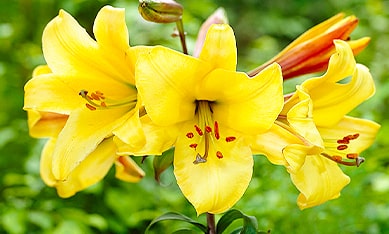
Trumpet lily trees are a type of trumpet lily that grows on extremely tall stems that resemble tree trunks rather than actual trees. Numerous substantial, fragrant flowers cascade from the top of these plants, which can grow to a height of up to 8 feet.
Trumpet lily trees are ideal for creating a focal point in your garden or patio, as they will attract attention and admiration from anyone who sees them. They are also easy to grow and care for, as they have similar requirements as regular trumpet lilies.
Here are some tips for growing trumpet lily trees:
1. Choose the right location: Trumpet lily trees need a location that gets at least 6 hours of sun per day, but also some shade during the hottest part of the day. They also need a location that has good air circulation and drainage.
2. Prepare the soil: Trumpet lily trees prefer a neutral soil that is rich in organic matter and well-drained. You can amend your soil with compost, peat moss, or manure to improve its fertility and texture. You can also add some sand or grit if your soil is too heavy or clayey.
3. Plant the bulbs: Trumpet lily tree bulbs are best planted in fall or spring when the soil is cool and moist. You can plant them 12 to 18 inches apart and 10 to 12 inches deep, with the pointed end facing up. You can also add some bone meal or slow-release fertilizer to the planting hole to encourage root growth and flowering.
4. Water and mulch: Trumpet lily trees need regular watering during the growing season, especially when they are forming buds and blooming. You can water them once or twice a week, depending on the weather and soil conditions. You can also mulch them with organic material such as straw, leaves, or bark to conserve moisture and prevent weeds.
5. Steak and deadhead: Trumpet lily trees need staking to support their tall and heavy stems. You can use bamboo stakes, metal rods, or wooden sticks to tie them loosely with twine or soft cloth. You can also deadhead them by removing the faded flowers to prolong their blooming period and prevent seed formation.
6. Prune and divide: Trumpet lily trees need pruning to remove the yellowing or dying foliage after they have finished blooming. You can cut them back to about 6 inches above the ground, leaving some green leaves to nourish the bulbs. You can also divide them every 3 to 5 years to prevent overcrowding and improve their vigor. You can dig up the clumps of bulbs in fall or spring and separate them gently by hand or with a knife. You can replant them immediately or store them in a cool and dry place until ready to plant.
How to Protect Trumpet Lilies from Pests and Diseases
Trumpet lilies are generally resistant to most pests and diseases, but they may still encounter some problems that can affect their health and beauty. Here are some of the common pests and diseases that affect trumpet lilies and how to protect them:
Lily beetles are bright red insects that feed on the leaves, stems, and buds of lilies. They can cause severe damage and defoliation if left unchecked. You can control them by hand-picking them and dropping them into a bucket of soapy water, or by spraying them with an insecticidal soap or neem oil. You can also prevent them by covering your lilies with a fine mesh netting or by planting companion plants such as garlic, onion, or marigold that repel them.
Aphids are small, soft-bodied insects that suck the sap from the leaves and stems of lilies. They can cause wilting, curling, and yellowing of the foliage, as well as transmit viral diseases. You can control them by spraying them with a strong jet of water, or by applying an insecticidal soap or neem oil. You can also prevent them by attracting beneficial insects such as ladybugs, lacewings, or hoverflies that feed on them.
Thrips are tiny, winged insects that feed on the flowers and buds of lilies. They can cause discoloration, distortion, and scarring of the petals, as well as reduce the fragrance and longevity of the blooms. You can control them by removing and disposing of the affected flowers and buds, or by spraying them with an insecticidal soap or neem oil. You can also prevent them by avoiding over-fertilizing your lilies, as this can make them more attractive to thrips.
A fungal disease that affects the leaves, stems, and flowers of lilies is known as botrytis blight. Brown spots, gray mold, and rotting of the impacted parts are the results. It thrives in moist, muggy environments. You can either remove and dispose of the infected plant material or use a fungicide like copper or sulfur to control it. Additionally, you can stop it by enhancing the drainage and airflow around your lilies, avoiding overhead watering, and refraining from sprinkling water on the foliage.
Lily bulbs are afflicted by the bacterial disease known as bulb rot. The bulbs become softer, discolored, and start to decay as a result. It is typically brought on by inadequate drainage, excessive watering, or damage to the bulbs. The infected bulbs can be dug up and thrown away, or you can treat them with a bactericide like streptomycin or oxytetracycline. Additionally, you can avoid it by planting your bulbs in loose, well-drained soil, giving them only moderate watering, and handling them with care.
Trumpet Lily Bulbs: How to Store and Replant for Year-Round Blooms
Trumpet lily bulbs are perennial plants that can be stored and replanted for year-round blooms. Here are some tips on how to store and replant trumpet lily bulbs:
You can store trumpet lily bulbs in fall or winter when they go dormant after blooming. You can dig them up carefully with a spade or fork, shaking off any excess soil. You can trim off any foliage or roots to about 2 inches above the bulb. You can dust them with some fungicide powder to prevent fungal infections. You can place them in paper bags, cardboard boxes, or mesh bags filled with peat moss, vermiculite, or sawdust. You can label them with their name and color for easy identification. You can store them in a cool and dry place such as a basement, garage, or shed with a temperature of 35 to 50 degrees F (2 to 10 degrees C).
You can replant trumpet lily bulbs in spring when the soil is workable and frost-free. You can choose a location that meets their growing requirements (see Planting Trumpet Lilies section above). You can prepare the soil by loosening it and adding some organic matter and fertilizer. You can plant the bulbs 4 to 6 inches apart and 8 inches deep, with the pointed end facing up. You can water them well and mulch them with organic material to conserve moisture and prevent weeds.
By following these tips on how to store and replant trumpet lily bulbs, you can enjoy their beautiful blooms year after year.
Frequently asked questions about Spring Flowering Trumpet Lilies
Are there any special tips for caring for trumpet lilies?
To get the best out of your trumpet lilies, we recommend providing them with sufficient nutrients, watering them regularly and removing the faded flowers. Also make sure that the plants receive sufficient sunlight.
When do trumpet lilies usually flower?
Trumpet lilies usually flower in late spring to early summer, depending on the variety and climatic conditions. The flowering time can vary, but they are known for their showy, fragrant flowers.
Are Dutch trumpet lily bulbs hardy?
Trumpet lilies are generally hardy, but you can protect them with a layer of mulch to protect them from extreme winter conditions. In regions with very cold winters, digging up the bulbs and storing them in a frost-free area may be a good option.
Which varieties of trumpet lily bulbs do you offer?
In our shop you will find different varieties of trumpet lily bulbs, including the classic Lilium longiflorum, but also other popular varieties such as 'Casa Blanca' and 'African Queen'. We endeavour to offer a diverse selection to meet the different preferences of our customers.
Can I buy Dutch trumpet lily bulbs in your shop?
Yes, you can buy trumpet lily bulbs from our online flower and plant shop. We offer a selection of high-quality bulbs in different varieties. Visit our website to explore our current assortment.











